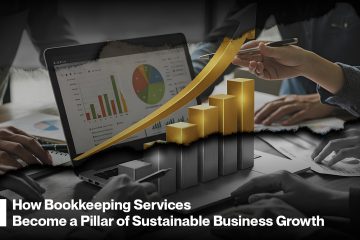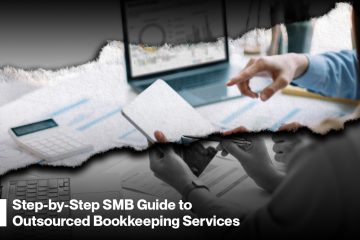Imagine it’s the end of the month and paperwork stretches toward the ceiling. You’re knee-deep in receipts reconciling accounts by hand while your competitors slide past making business decisions with a fraction of the hassle. Does this sound too familiar? For thousands of U.S. businesses, the dilemma between accounting automation and manual accounting is more than just an operational headache. It’s a financial crossroads that’s quickly defining winners and losers in this new era.
As a U.S. accounting outsourcing firm that’s helped clients bridge the divide for years, we’ve seen first-hand how transformative accounting automation benefits can be for businesses of all sizes. Let’s break down the hidden costs, the big wins and the path forward as you decide: is it really the time to switch from the old to the new?
The Cost of Manual Accounting: Beyond Calculations
Manual bookkeeping feels like “business as usual” but the numbers tell a harsh story. Did you know that accounting errors and manual financial reporting cost U.S. businesses a jaw-dropping $7.8 billion annually? That’s a billion with a “B” and it definitely doesn’t end here.
For most small to mid-size businesses, manual processes account for an average of 10 hours a week spent on data entry and transaction management. That’s over 500 hours a year, not counting the countless hours spent on error correction.
At a modest $25/hour wage, that’s $26,000- $30,000 annually just for manual labor excluding the stress and missed opportunities this creates.
However, the true price of sticking with manual accounting is even steeper:
- Decision-making gets delayed because you’re working with outdated financial data.
- Errors multiply increasing the risk of costly tax penalties.
- Staff morale plummets as burnout sets in.
- Growth stagnates because your team’s tied up in routine instead of focusing on strategy.
75% of companies are forced to handle accounting tasks manually because their systems are so error-prone that automation isn’t even possible. If you’ve ever felt like you’re stuck in accounting quicksand, you’re not alone.
Accounting and Automation: The Benefits Speak for Themselves
What happens when companies embrace accounting automation?
Time Savings Like Never Before
Modern automated accounting and automation systems slash bookkeeping workloads by 40- 70%.
For example:
- An e-commerce business that automated its financial systems reported reclaiming 25 hours a week. That saved time went straight into launching new products.
- QuickBooks users save an average of 40 hours per month by moving to automated processes.
- The feared bank reconciliation that once took 16 hours now clocks in at just 2- 3 hours with efficient accounting automation.
Dramatic Cost Reductions
The math is clear:
- Goldman Sachs found automation reduces processing costs by 60- 70%.
- Processing a single invoice drops from $16.00 to $5.89 for medium-sized businesses and from $22.26 to $6.89 for small businesses with automation in place.
- Automated departments process 16 times as many invoices per employee compared to manual teams (22,756 vs. just 1,350!).
Error Reduction That Can Save Your Business
Manual entry mistakes are, unfortunately, a fact of life in accounting. Automated systems aren’t perfect but they reduce errors by up to 90% with some solutions boasting 95% accuracy in data capture. This is about more than embarrassment. It’s about avoiding penalties, lost opportunities and compliance nightmares.
Real-World ROI Stories
Numbers are one thing but stories make it real. Check out these real-life results:
- A bicycle parts manufacturer saved $14,400 yearly after investing $7,000 in accounting automation software. Almost a 106% ROI in the very first year.
- Restaurants using AP automation found that finance departments could stay lean focusing on higher-value work instead of hiring new bookkeeping staff with every incremental business increase.
- Some studies show that accounting automation can deliver up to 290% annual ROI once implemented, often in just 8–12 months.
The Automation Revolution: A Wave You Can’t Ignore
Embracing accounting and automation tools isn’t just a passing trend. The entire financial service industry is experiencing a groundswell:
- In just one year, the proportion of invoices manually entered dropped from 85% to just 60%.
- Today, 83% of professionals trust accounting automation for critical tasks and 56% would trust artificial intelligence for complex accounting.
- A.I. and automation now handle up to 75% of routine financial reporting and 85% of repetitive accounting tasks with today’s technology.
- A staggering 67% of accountants believe A.I. will be the norm within five years, and 89% of companies have already adopted or are planning to adopt A.I. in their accounting operations.
These trends aren’t hypothetical. They’re reshaping accounting departments everywhere.
Manual vs. Automated Accounting: What Are the Challenges?
Look, no system is perfect. Here are the realities:
Manual Accounting: The Old Reliable (But At What Cost?)
- Scalability Issues
Manual recording simply can’t keep up as transaction volumes increase. - Human error is ever-present. A misplaced decimal can cost thousands.
- The time drain is enormous.
- Limited insights
Real-time reporting and analytics are virtually impossible with paper-based or spreadsheet systems.
Accounting Automation: It’s Not Without Bumps
- There is an initial investment: Good tools require some capital plus training time.
- There’s a learning curve. Teams need support as they transition.
- Technology maintenance
You’ll need occasional updates or help desk support. - Integration can be complex when connecting to legacy workflows.
Let’s be honest, most of these are one-time hurdles whereas the costs of manual systems continue to climb year after year.
Making the Bet: When Should You Automate?
Manual accounting may still make sense if…
- You’re a very small business (fewer than 50 transactions/month).
- You have a simple, singular revenue model.
- Budgets are ultra-tight with no growth plans.
- Your in-house team is invested in the manual status quo.
Automation quickly becomes a necessity when…
- Transaction volume consistently exceeds 100/month.
- Multiple revenue streams require complex tracking.
- Business growth is a priority or you want to scale quickly.
- You need real-time data for crucial decisions.
- Compliance requirements get more complex.
The real question is not whether automation pays off but how long until your competition’s productivity leaves you behind.
Roadmap for Making the Move: How to Transition to Accounting Automation
Are you ready to ditch the spreadsheet mountain for something that actually works for you? Here’s your practical guide:
- Assess Where You Are
- Calculate your real costs including, but not limited to, labor, errors and opportunity cost.
- Identify where you’re losing the most time or making the most mistakes.
- Do Your Research
- Look for solutions that integrate with your current processes.
- Check for real support and training options.
- Choose cloud-based systems for scalability and flexibility.
- Plan the Rollout
- Start with a pilot program in a discrete area.
- Invest in comprehensive training upfront.
- Set clear (realistic) benchmarks for success after implementation.
- Measure, Optimize & Scale
- Continuously track your savings and error reductions!
- Adjust processes, retrain as needed and drive automation across the organization.
The Final Word: It’s Not Just About Saving Money
While the cost savings of accounting and automation can be spectacular (with ROI often exceeding 100% in the first year), the real benefit is what it allows your business to do next.
Teams liberated from grunt work become strategic partners who are able to advise and innovate. Decision-making accelerates, your business becomes more resilient and you finally have the data agility you need to thrive.
Today, 75% of companies report significant competitive advantages from workflow automation. The big question isn’t whether automation will take over. It’s whether you want to lead the pack or get left with a ledger and a calculator.
Ready to join the automation revolution?
As financial technology races ahead, you deserve a partner who understands both old-school accounting rigor and the game-changing potential of modern tools.
That’s where our team at Glocal Accounting steps in! We combine traditional human expertise with automation technology ensuring you get the best of both worlds as you future-proof your finances.
If you’re still spending late nights with spreadsheets, remember that the future belongs to those who automate today. Let’s talk about how Glocal Accounting can partner with you for success.
SOURCES
All statistics, case studies, and data points are drawn from the following (for more detail, visit the original sources):
- DOKKA, “Key Accounting Automation Stats for 2025”
- Gaper, “Manual Vs. Automated Accounting: What Are the Key Differences”
- Leapfin, “The State of Accounting Automation Signals a Call for Change”
- Accounting Web, “Invoice Automation: How Return On Investment in 1 Year is Possible”
- BlackLine, “Measuring the Real Cost of Manual Accounting”
- TaxDome, “Accounting automation 2024: key benefits, technologies, and how to”
- CoreIntegrator, “The ROI of AP Automation – A Case Study”
- QuickBooks, “Automated Bookkeeping Software Saves Time”



0 Comments